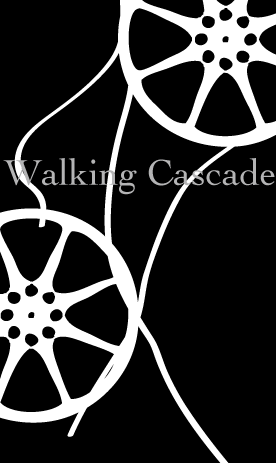Walking Cascade
iron, videotape, motor, roller, video, etc., Dimension variable, 2016
BUSAN BIENNALE 2016
Project 2- F1963
Exhibition Period: Sep. 3~Nov. 30, 2016
Exhibition Venue: Busan Museum of Art, F1963(KISWIRE Suyeong Factory)
STATEMENT
私たちの日常は、映像などのデジタル・メディアを介した情報であふれている。本展のために新たに考案された《Walking Cascade》において、オル太はデジタル・メディアによる伝達体験を河川や湖から流れ落ちる滝に喩えた。人が滝に対峙する時の体験は、現地までの道のり、眼前に広がるパノラマ、水の流れる音やしぶき、周囲の温湿度や環境などを全感覚で体得する。よってその記録映像は二次的なものである。現代の情報化社会において、経験や記録の在り方が逆転し、映像による視覚経験が一次的なものとなることがしばしば起こるが、では、知覚の構造はいかに普遍的でまた変容しているのであろうか。本作品は、映像を生み出す身体、それを受容する身体、そしてその記録を伝える媒介にかかる蓄積と変化を視覚化する試みである。
オープニングではオル太によるパフォーマンスが行われる。このパフォーマンスは日本の六斉念仏踊り(ろくさいねんぶつおどり)に着想を得ている。各家の前で精霊供養のために踊られ、関西地方の農村を中心に分布するこの民俗芸能の伝承、芸態は地域により異なるが、例えば、太鼓、鉦(かね)、笛などと共に少人数で一晩中踊り続けられていたようだ。オル太のパフォーマンスでは日常品などで新たに作られた楽器と自身の声が奏でられ、舞いが展開する。そして、このパフォーマンスが記録された映像が展覧会の会期中再生されることにより、行為は再演され続ける。作家という身体を媒介した実践と再演、映像による記録と再生、そしてこれらに対峙する鑑賞者の身体の介在により、意味の絶え間ない変換と更新がインスタレーションという場で繰り広げられる。そうして《Walking Cascade》は身体を介する伝承と情報の変容と在り方を問う。
編集:北出智恵子
Our daily life is flooded with an enormous amount of information transmitted by media such as video. In Walking Cascade, OLTA likens such experience, driven by the digital media, to a waterfall. When you confront a waterfall, you receive the experience with all your senses; the journey to the site of the waterfall, the panorama in front of you, the sound and the splash of falling water, the temperature and humidity, and the surroundings. In this context, recorded video is seen as secondary. However, in contemporary information-driven society, the relationship between the physical experience and the document is reversed, and the visual experience conveyed by the video document often becomes primary. The question then arises as to whether the structure of the perception is still universal, or whether it is changing? With this new work OLTA tries to visualize the accumulation and transformation of information in three ways. Firstly, through the artists’ bodies as the creators of video. Secondly, through bodies as its receivers. Finally, through media which document and record.
At the opening of the exhibition, OLTA gives a performance inspired by Rokusai Nenbutsu Odori, a traditional Japanese Buddhist folk dance that is performed mainly by farmers in Western Japan in honor of spirits. In spite of its variety of forms and traditions, it is often the case that a group of a few people visit each house in a village and dance all night accompanied by drums, bells, and flutes. In OLTA’s performance, the members dance to the sound of their own voices and original instruments improvised from household objects. This performance is recorded and then replayed repeatedly throughout the exhibition period. The continual transformation and updating of the meaning are actualized on site through the performance and its subsequent replay; through the video on which the performance is recorded and its replay; and through the bodies of the viewers encountering the installation.
Text: Chieko Kitade
English Proofreader: Matthew Britain












